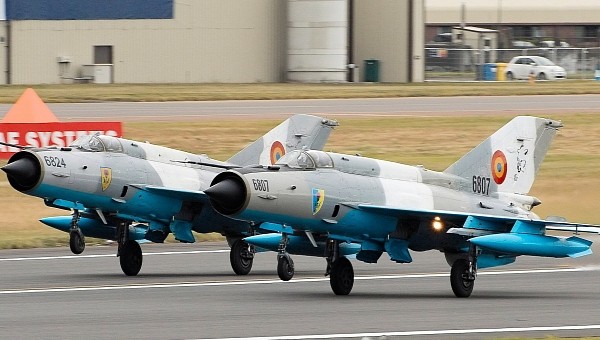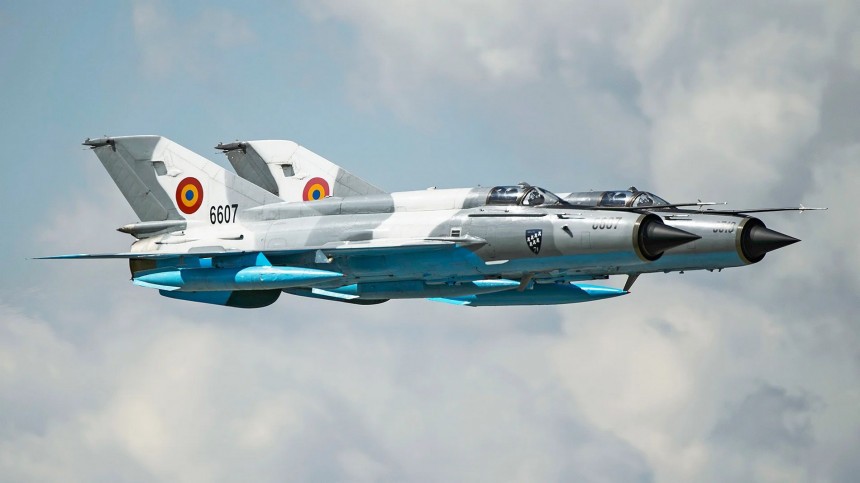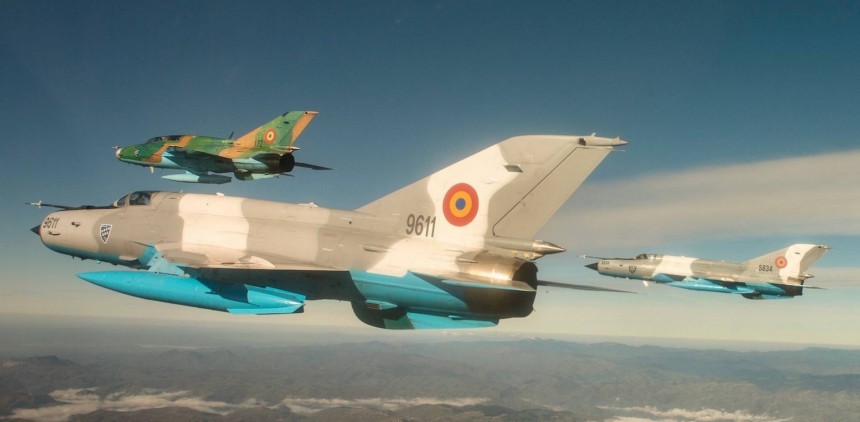The Mikoyan-Gurevich MiG-21 (NATO Codename: Fishbed) is one of the defining single-engine jet fighters of any nation in the 20th century. A platform that's so easily adaptable and beloved by its pilots that a handful of Air Forces 60 years post-introduction are hesitant to get rid of them.
But apart from forming the backbone of several African and Caribbean Air Forces in the 2020s, only two militaries in the "developed world," whatever that means this week, still employ the MiG-21. We'll be sure to take a closer look at India's MiG-21 upgrade package sometime soon. But for now, this is the story of the MiG-21 LanceR (often stylized as LanceR), the Romanian Air Force's Eastern Bloc hammer.
Though routinely overshadowed by more prominent Air Forces in Western Europe, Romania is home to one of the most historic and deeply rooted aviation programs outside of the United States. Merely three years after the first flight of the Wright Brothers, the Romanian inventor Traian Vuia was designing single-wing monoplanes with contemporary tractor-style propellers that made the Wright Flyer look primitive.
Later still, in the Second World War, the Romanian IAR group fielded the spectacular IAR80. A sleek, powerful, and capable single-engined fighter on par with German and Japanese planes like the Bf-109 and A6M Zero but also the British Hurricane and the American Wildcat. Even into the Cold War, Romania's supported a strong domestic military aircraft sector, manufacturing planes like the IAR-93 Vultur (Eagle) ground attack jet in conjunction with Yugoslav engineers.
Our point in relation to the MiG-21 is this. If there were a NATO member state best suited to pairing the most capable Soviet jet fighter of the 20th century with 21st-century hardware, Romania certainly fits the bill. The Romanians fielded their first batch of MiG-21s delivered straight from the Soviets in 1962, with another 12 of the very same F-13 models coming the following year.
By the early 1990s, the Romanians fielded a fleet of over 320 MiG-21 airframes of multiple bespoke models and upgrade packages supplied by both their own R&D teams and with help from the Soviets. The relationship between Romania and the Soviet Union hadn't been on the best terms since their early 1960s political split spurred by both the death of Joseph Stalin and Romania's own dictator Nicolae Ceausescu's desire to court lucrative business deals with both the East and the West.
The results of having to make due in the Air Force department with second-hand Soviet hardware that wasn't always the best on paper culminated with the MiG-21 LanceR. With help from the Israeli-based Elbit Systems, most known for their world-renowned military UAV products, a Romanian state that violently ditched communism and eventually joined NATO turned their MiG-21s into something of a pariah.
This isn't the only instance where NATO has commandeered Eastern Bloc military aircraft for their own uses. Most notably, the MiG-29 Fulcrum was a stalwart of NATO aggressor squadrons designed to mimic opposing air forces in mock air battles for training purposes. In truth, the MiG-21 LanceR variant was inspired by the struggles of the Romanian government to secure spare parts and engines for their fleet of MiG-29s and MiG-23s for the reasons stated above.
But unlike the Fulcrums, which were picked up and flown pretty much as they were, the MiG-21 LanceR is the polar opposite. The LancerRs themselves are upgrades of the MiG-21 MF and UM, some of which have served with the Romanian Air Force since the fleet first arrived. A total of 110 airframes were selected for this Israeli upgrade package. One which allowed a breadth of NATO radar, avionics, and weapons to be compatible with the former flagship of the Iron Bloc's fleet
With dimensions of 15.76 m (51.7 ft) long and a 7.15-meter (23.5 ft) wingspan, the LanceR is slightly larger than the equivalent MiG-21bis variant the Soviets used up until their dissolution. The majority of this extra length is accounted for with the upgraded EL/M 2032M pulse-Doppler radar in the newer Lancer Cs built for air superiority. Or an Elta EL/M 2001B in the older LancerR A and B built for ground/close-air support.
NATO-compatible radio transponders are a mundane thing for most established member-states. But implementing such tech for an entire Air Force in a very quick hurry was no small accomplishment. Nor was the installment of an ELTA EL/L 8222R electronic jamming pod that did a much better job of detecting enemy missiles than old Soviet hardware.
Through natively mounted weapons pylons or with the help of adapters, the LanceR accepts weaponry from NATO and non-NATO forces. From old Soviet R-73s to Israeli Pythons and even French Matra Magics, the selection of just air-to-air missile hardware is more eclectic than even what some American fighters have regular access to.
A single undercarriage pylon, once only good for fuel tanks, has been converted to carry the American-derived Mark 83 1000 lb (459 kg) low-drag unguided bombs. Or, if someone's feeling extra ex-communist, LancerRs A, B, and C can fly touting S-5 and S-24 unguided rocket pods or CL-250 cluster bombs. Powered by the archaic but powerful Tumansky R-13 turbojet engine, the MiG-21 LanceR can almost touch twice the speed of sound.
Not a bad upgrade package if you ask us. All the better because the MiG-21 LanceR platform is supported by a native Romanian aerospace firm called Aerostar, based out of the City of Bacau. Apart from outfitting the Romanian variant of the F-16 Fighting Falcon, Aerostar's other claim to fame is maintaining the entire fleet of MiG-21 LancerR in all its variants. Aerostar's refurbished and overhauled as many as 7,000 turbojet engines, according to their web page. They're some of the last people outside of Russia to claim expertise in the operation of the R-13 engine.
But make no mistake, even the most skilled domestic aerospace firm in all the land can't keep the MiG-21 in the air forever. With American-built F-16s already on the way, the Romanian Military has slated the MiG-21 LanceR to serve its final calendar year in 2024. Questions regarding the structural integrity of an airframe made by a nation that no longer exists nearly 60 years ago appear to be the main impetus behind its retirement.
Before too long, only the most desperate militaries around the world will be fielding MiG 21s that, at this stage, might as well be a part of ancient history. With J-20s, Su-57s, and F22s now prowling global airspace, the prospects of a MiG-21 in modern combat between Russia and NATO probably aren't all that favorable. So then, off to the museums with them. Or, more likely, the scrap heap. Over 10,000 MiG-21 airframes were built between 1959 and 1985. We can't hope to save them all.
Though routinely overshadowed by more prominent Air Forces in Western Europe, Romania is home to one of the most historic and deeply rooted aviation programs outside of the United States. Merely three years after the first flight of the Wright Brothers, the Romanian inventor Traian Vuia was designing single-wing monoplanes with contemporary tractor-style propellers that made the Wright Flyer look primitive.
Later still, in the Second World War, the Romanian IAR group fielded the spectacular IAR80. A sleek, powerful, and capable single-engined fighter on par with German and Japanese planes like the Bf-109 and A6M Zero but also the British Hurricane and the American Wildcat. Even into the Cold War, Romania's supported a strong domestic military aircraft sector, manufacturing planes like the IAR-93 Vultur (Eagle) ground attack jet in conjunction with Yugoslav engineers.
Our point in relation to the MiG-21 is this. If there were a NATO member state best suited to pairing the most capable Soviet jet fighter of the 20th century with 21st-century hardware, Romania certainly fits the bill. The Romanians fielded their first batch of MiG-21s delivered straight from the Soviets in 1962, with another 12 of the very same F-13 models coming the following year.
The results of having to make due in the Air Force department with second-hand Soviet hardware that wasn't always the best on paper culminated with the MiG-21 LanceR. With help from the Israeli-based Elbit Systems, most known for their world-renowned military UAV products, a Romanian state that violently ditched communism and eventually joined NATO turned their MiG-21s into something of a pariah.
This isn't the only instance where NATO has commandeered Eastern Bloc military aircraft for their own uses. Most notably, the MiG-29 Fulcrum was a stalwart of NATO aggressor squadrons designed to mimic opposing air forces in mock air battles for training purposes. In truth, the MiG-21 LanceR variant was inspired by the struggles of the Romanian government to secure spare parts and engines for their fleet of MiG-29s and MiG-23s for the reasons stated above.
But unlike the Fulcrums, which were picked up and flown pretty much as they were, the MiG-21 LanceR is the polar opposite. The LancerRs themselves are upgrades of the MiG-21 MF and UM, some of which have served with the Romanian Air Force since the fleet first arrived. A total of 110 airframes were selected for this Israeli upgrade package. One which allowed a breadth of NATO radar, avionics, and weapons to be compatible with the former flagship of the Iron Bloc's fleet
NATO-compatible radio transponders are a mundane thing for most established member-states. But implementing such tech for an entire Air Force in a very quick hurry was no small accomplishment. Nor was the installment of an ELTA EL/L 8222R electronic jamming pod that did a much better job of detecting enemy missiles than old Soviet hardware.
Through natively mounted weapons pylons or with the help of adapters, the LanceR accepts weaponry from NATO and non-NATO forces. From old Soviet R-73s to Israeli Pythons and even French Matra Magics, the selection of just air-to-air missile hardware is more eclectic than even what some American fighters have regular access to.
A single undercarriage pylon, once only good for fuel tanks, has been converted to carry the American-derived Mark 83 1000 lb (459 kg) low-drag unguided bombs. Or, if someone's feeling extra ex-communist, LancerRs A, B, and C can fly touting S-5 and S-24 unguided rocket pods or CL-250 cluster bombs. Powered by the archaic but powerful Tumansky R-13 turbojet engine, the MiG-21 LanceR can almost touch twice the speed of sound.
But make no mistake, even the most skilled domestic aerospace firm in all the land can't keep the MiG-21 in the air forever. With American-built F-16s already on the way, the Romanian Military has slated the MiG-21 LanceR to serve its final calendar year in 2024. Questions regarding the structural integrity of an airframe made by a nation that no longer exists nearly 60 years ago appear to be the main impetus behind its retirement.
Before too long, only the most desperate militaries around the world will be fielding MiG 21s that, at this stage, might as well be a part of ancient history. With J-20s, Su-57s, and F22s now prowling global airspace, the prospects of a MiG-21 in modern combat between Russia and NATO probably aren't all that favorable. So then, off to the museums with them. Or, more likely, the scrap heap. Over 10,000 MiG-21 airframes were built between 1959 and 1985. We can't hope to save them all.












